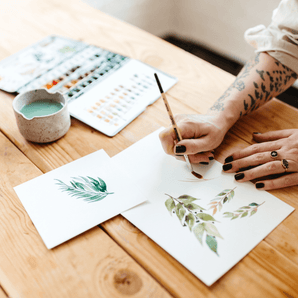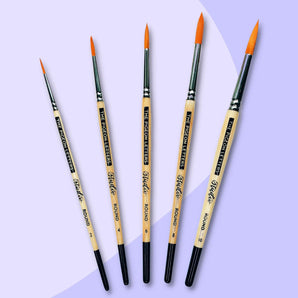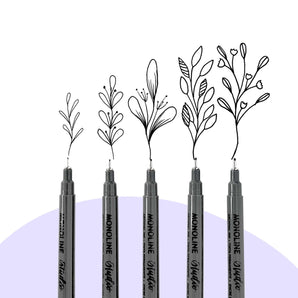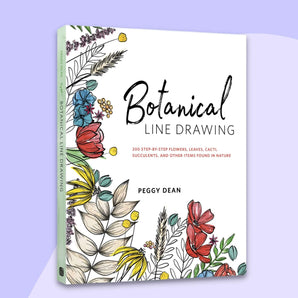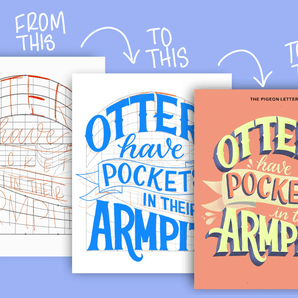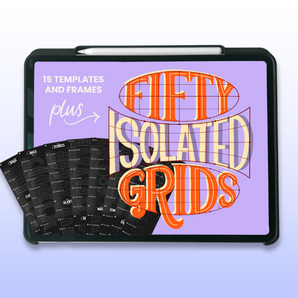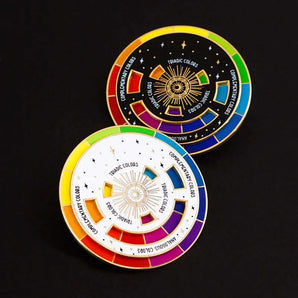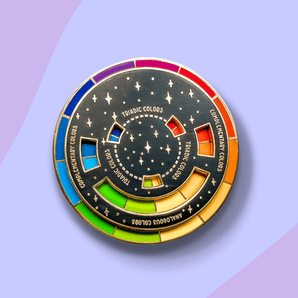It always makes my day to receive a handwritten letter or greeting card through the old-fashioned, snail mail system. It is usually unexpected, and very heartwarming. I usually end up reading the letter twice, appreciating the little details - the handwriting, the stickers, the little doodles...it feels very personal, meant only for me. Personalized cards are a wonderful way to show someone they are important and loved.
Hey there everyone! I’m Vi from @bloomsandbreakfast. I am an artist that is very much inspired by flowers and plants, color palettes, and sometimes, food! My favorite mediums are watercolor and gouache paint so today we're going to create something simple and sweet, like this simple cosmos flower painting.
Supplies:

Step 1: Sketch the Flower

Let us start by sketching on the right half of our watercolor paper. The cosmos flower has a small center, and it usually has 8 petals. The petals are widest close to the edge of the petal and have straight folds and creases from the center going out towards the edge. The edge of the petal is somewhat jagged or scalloped. In case you would need a reference, there are a lot of photos on unsplash.com.


New to floral paintings or drawing flowers and plants? Don't worry, I've got books just for you!
Step 2: Paint the Outlines

Once we’ve got the flower pencilled in, let us mix some gouache - I'm using the colors Rose and White - to get a medium pink shade. Gouache is a pretty thick medium so you’ll need to add enough water to get a smooth and workable consistency. With your detailing brush, outline the petals.
If you want more gouache tutorials, try painting a jasmine branch or incorporate watercolors into it, too!
Step 3: Paint the Petals

Next, let’s color in our petals with the color Rose with our medium brush. Paint inside the light pink outline, and use strokes that start from the center of the flower to the edge of the petal. This way, any unevenness of the paint coverage and paint strokes will look like the folds and creases of the cosmos.
Step 4: Add Shadows

There is a trick in giving dimension to our painting: adding shadows. Let us mix the shadow color - Rose + Burnt Umber. Using our detailing brush, let us paint shadows where the petals overlap. Also, paint shadows around the center. It’s looking pretty 3D now, isn’t it?!
Step 5: Add Creases and Folds

With the same mix we used for the shadows, let us go ahead and paint in those creases. Starting from the center, paint your creases going toward the edge of the petal. We can have creases that stop midway, or creases with broken lines, or creases from the edge coming in, ... be creative and experimental!
Step 6: Add Highlights

Another trick in adding dimension to our painting is by adding highlights. Using White gouache, add highlights to the parts of the petals where the light will hit.
Step 7: Paint the Center

Still using our detailing brush, let’s color in the center with a mix of Lemon Yellow and Yellow Ochre.
Step 8: Add More Detail

Once it’s dry, let’s add some details using a mix of Burnt Sienna and Yellow Ochre. Add some little specs and a jagged edge.
Step 9: More Dimension

For added dimension, using Burnt Umber, add some little details to separate the petals from the center.
The cosmos bloom is complete! You can go ahead and add other details like other flowers, stems....

... and leaves. I used a mix of Mid Green and Yellow Ochre for my stems and leaves.

Fold in half, fill it up with a thoughtful message, and you are now ready to make someone feel extra special with your handmade, personalized card!

Hi everyone! I am Vi Chung, the artist behind @bloomsandbreakfast.
I am very much inspired by florals, patterns, color palettes and food. My trademark style has been described as having intricate detail and depth. I am familiar with water based paint products like watercolor, gouache and acrylic. Currently, I am one of the Brand Ambassadors for Art Philosophy. You can check out my account to see more of my work.
Want to come back to this beautiful flower later? Pin it!






